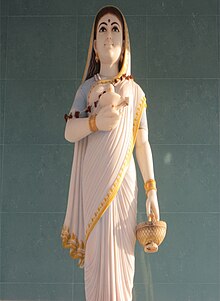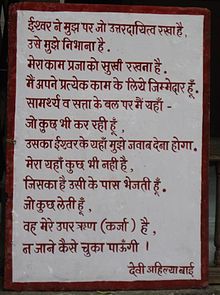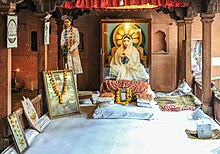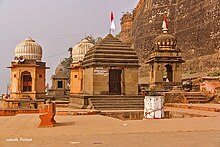Ahilya Bai Holkar

Ahilya Bai Holkar (also Ahilyabai or Ahilyābāī Holkar , earlier also Ahilya Baee, hindi अहिल्या बाई होळकर, born 1725 (?), Died August 13, 1795 ; reign 1765–1795) was a princess of the West Indian Marath people from the Holkar family who ruled from their residence in Maheshwar on the Narmada , the old capital of the Holkar, 100 km south of Indore , over their Malwa province in what is now the Indian state of Madhya Pradesh .
While she was already considered an exemplary country mother during her lifetime because of her lifestyle and statecraft , after her death she was venerated as a saintly figure in her homeland to this day.
Life
Origin, marriage
Ahilya Bai came from a farming family. Her future father-in-law, the founder of the Holkar Princely House , Malhar Rao Holkar (1693–1766), who came from a humble background, met her while passing through her village and, because of her serious, pious demeanor, appointed her to his only son, Khande Rao Holkar (1723–1754), to the bride, who she married in 1733. In 1745 she gave birth to a parent , the future ruler Male Rao Holkar (1745–1767), and in 1748 a daughter, Mukta Bai.
Ahilya Bai, though not beautiful, was slender, moreover brightly intelligent, cheerful and friendly, of a natural nature, strong will, and a lofty, noble sense of her duties; moreover, she could read and write, as evidenced by her correspondence, and understood the Puranas (scriptures), which she read with fondness. With the death of her husband in the Battle of Kumher , Rajasthan, in 1754, she became a widow at a young age and only the intervention of her father-in-law kept her from the ritual self-immolation, the sati .
Reign for her son
Introduced into the practice of government by her father-in-law, as administrator of her own jagir (fiefdom) and sometimes even given detailed military instructions, Ahilya Bai soon grew into the daily business of the principality.
"" ... don't even stop in Mathura to drink water, but move on [with the army] after crossing the Chambal to Gwalior. You can rest there for four or five days. Keep your heavy artillery together and get as much ammunition as possible as possible (January 31, 2765) ... have bullets made for the cannons and for the artillery carried on camels in order to replenish your ammunition stocks ... If you have to take a fortress ... always make sure you have enough artillery a fort - whenever possible, achieve your goal with prestige instead "(November 4, 765)."
Since her widowhood, she has only dressed in simple white robes - white is the color of mourning for the Hindus - she renounced any kind of jewelry, but after the death of her father-in-law in 1766 she claimed the reign of her son Male Rao.
"" It was an extraordinary sight, however: a woman without vanity, a bigot without intolerance ... today she is considered an avatar , a rebirth of the divine ""
The son Male Rao had already shown signs of mental confusion before he took office, before he died in disorder in 1767 after only nine months of reign. The daughter Mukta Bai, who was excluded from inheritance due to her marriage according to Hindu inheritance law, carried out that public widow burning after the early death of the husband and her only son against the bitter, almost violent resistance of Ahilya Bai and to their inexpressible grief, that public widow burning (Sati ), which she herself had renounced at the time.
Sole government
Ahilya Bai was left on her own after the loss of her husband, father-in-law, both children and grandchildren. She rejected the proposed adoption of an heir to the throne and claimed the power of government for herself, citing the law of inheritance; a patent of their nominal overlord, the Peshwa of Pune , officially confirmed their claim to power in 1767.
Government dualism
She immediately assigned General Tukoji Holkar , who was the same age but not related to her, to lead the army in the north and south ( Dekkan ), while she herself took care of the government and civil administration of the Malwa proper - a dualism ( do amīn , "two Herrschaft "), which proved itself in this personal constellation. Ahilya Bai's status as ruler was never in question. In the years of cooperation there does not seem to have been a single serious quarrel or difference of opinion between the general and his princess
It was also unusual for the time that there was no significant change in management during her thirty-year reign. Its first minister, the brahmin Khande Rao, was considered to be of "excellent character" (Malcolm), and the holders of the other posts also seem to have given no cause for dissatisfaction.
“The shared responsibility lasted about thirty years, untroubled by jealousy or ambition. The main reason for this was the competence with which Ahalya Bai handled civil affairs, the support she gave to Sindhia (a loan of 3 million rupees) and the reputation of holiness that she earned through her charity. "
daily routine
Her normal daily routine began an hour before sunrise with morning prayer and listening to the holy books, after which she gave food and alms to Brahmins. After the (vegetarian) breakfast she prayed again and then took a short break. Around two in the afternoon she stopped at Darbar (courtyard) until six in the evening, after which she prayed again for two to three hours and had a simple meal. From nine o'clock to eleven in the evening she did official business again before she retired.
Jurisprudence
The jurisprudence was a special concern of Ahilya Bais, she spoke daily personally (and unveiled) in public darbar (court, court) law, regardless of person, status or bribes. She issued few death sentences, warned against them, but kept the lawbreakers in check by means of strict but moderate judiciary.
Economic Policy, Promotion of the City of Indore
Ahilya Bai founded and promoted the Indore settlement on her territory , which grew into a large city under her. She confirmed property rights and observed them; She did not permit the confiscation of assets whose owners had died without children or without male heirs in favor of the state treasury or third parties (Brahmins, etc.); the legacy was retained by the families, even without paying bribes.
Finance, foreign policy
She kept the three areas of state, family and private wealth strictly separated from one another and accounted for them precisely. She took care of foreign policy through envoys ( Wakils ) appointed by her at the foreign courts, just as numerous diplomats or agents from neighboring Indian states were active at her court.
Of great importance for the security of her dominion was her good relationship with the most powerful Marathen neighbor, Mahadji Sindia von Gwalior, whom she knew how to keep from invading her home country both by a large loan and by her prestige.
Politics towards the tribes ( Adivasi )
She assured the tribal groups of the Bhils and Gonds residing in her territory that their possessions would continue to exist and be inviolable against the condition that, for a small fee - at the expense of those passing through - they would ensure the safety of the traffic routes that led through their area; this arrangement proved extremely effective, practical and peaceable
Religious, social and “investment” charity
Their charity extended well beyond the boundaries of their rulership to the four Char Dham , systematically through their Brahmin agents throughout India from Kedarnath in the extreme north to Rameshvaram in the extreme south, from Dvaraka in the west to Jagannath / Puri in the east , Had or promoted temples, fountains, shrines and ghats (entrances to the holy rivers), considering not only the Hindu sanctuaries of Shivaite faith - the Holkars were Shivaites - but also Vishnu - and other denominations of the Hindu spectrum. Muslim pilgrimage and pilgrimage sites, especially the fakirs , also benefited from their donations and sanads (patents). She supported hundreds of Brahmin families and sponsored numerous religious festivities as "royal, dharmic donations ". 150 years later, a common saying reminded of Ahilya Bai's economically stimulating building activity:
"होलकरी टाकी चालु टेकी - Chisel of the Holkar, keep working!"
Infrastructure, charity
Roads too - e.g. B. over the steep slopes of the Vindhya Mountains - and had forts built. In the hot times she had water distributed on the highways, partly for the migrating cattle, organized folk festivals, distributed food to the poorest every day and clothes in the cold season. She left fields lying fallow, which provided the birds with the necessary fodder as a charity and, on the other hand, kept the flocks of birds away from the farmers' fields.
Religious politics
Communalist unrest, as it was the order of the day between the Muslim and Hindu populations then and now, did not occur under her rule: "Both Muslims and Hindus prayed together for their long lives and well-being."
Tax policy
Her biographer Malcolm already described her policy of deliberately low taxes as the key to the prosperity of her principality; Like the Prime Minister of the neighboring state Ahmednagar , the Abessynian Siddhi Malik Ambar (1549–1626), two centuries before her , she laid the foundation for the prosperity of her state, stimulated cultivation and trade, attracted private and public investments and filled them State coffers not through forced collection, confiscation and high tax rates, but through voluntary immigration, population and economic growth. Their concept was already considered exemplary among contemporaries; in contrast to their marathic neighbors, who are extremely active due to their military conquests; B. of the Peshwa of Pune , she remained debt-free and could borrow money cheaply at any time.
Last years, death
Ahilya Bai died, probably exhausted from too strict fasting, in 1795 without an heir.
Afterlife
She was followed on the Gaddi (throne) for two years by her seventy-year-old militarily capable but politically hapless general Tukoji Holkar - "a good soldier, a simple and unaffected man, whose courage exceeded his agility, which is no small praise for a marath leader" (Malcolm). After his death at the age of 72 in 1797, his four sons from a legitimate and an illegitimate marriage fought over the inheritance. Malwa, under Ahilya Bai's good governance, still a prosperous, well-ordered principality without internal unrest and undisturbed by incursions through clever foreign policy, sank within two years in the succession battles between the Holkars to one of the most devastated and run-down regions - "the general hunting ground of all kinds of bands of robbers "(Edwardes) of the country not poor in destruction, before the British took power in 1818.
Illustration
A statue of Ahilya Bai is below. a. in the Vishnupad temple of Gaya ( Bihar ), which she donated .
criticism
The marathic historian GS Sardesai lamented the military reluctance of Ahilya Bais, especially towards the neighboring princes of Gwalior , the Sindhia (or Shinde), whose rise falls during this period. Their lack of interest in questions of power contributed to the downfall of the Peshwa of Pune , their Marathic overlord, who was dependent on them , and of the Marathas as a whole. CE Luard also judges in The Cambridge History of India . Ahilya Bai's troops were definitely there, by no means a peace corps (Dighe) and among foreign officers, e.g. B. the French Dudrenec or the American Boyd, well educated and under the leadership of Tukoji Holkar constantly in action, but only abroad, i. H. in the north Indian Hindustan and in the south Indian Dekkan . The Indian historian Jadunath Sarkar pointed out that Mahadji Sindhia could never have assumed his dominant position without the active support of Ahilya Bai's troops.In addition, the House of Holkar was able to take on the further rise of the rival House of Sindhia, with whom it even went to battle in 1793 came at Lakheri, Rajasthan, have no interest. Ahilya Bai was not lacking in courage, in crisis situations she also led her troops personally , armed on an elephant howdah .
Her biographer Malcolm asked whether it was wise to spend as much money as she did for pious purposes and was confronted by a Brahmin with the counter-question whether Ahilay Bai would bring her country the same peace by providing even twice as much for the military and would have brought prosperity as through their charity.
Quotes
- "... one of the most extraordinary rulers in India of the 18th century ... probably the best administrative manager of the Marathas at all"; Stewart Gordon 1993
- "Ahilya Bai's successes in the internal administration of her area have been wonderful ... The basic trait of her life was to promote the well-being of all people around her; I was told that she was happy when she got rich from bankers, merchants, farmers and farmers ... In short, it was generally accepted as a model for good administration in Malwa "; Malcolm 1832
Web links
literature
- John Malcolm : A Memoir of Central India, including Malwa, and Adjoining Provinces. With the History and Copious Illustration, of the Past and Present Condition of that Country. 2 volumes. 3rd edition, London: Parbury, Allen 1832 (1st edition, 1823). - The British officer of the East India Company John Malcolm (1769–1833) participated in the Marathas and was able to interview Ahilyabai's contemporary witnesses; it is therefore still the most important source for the later history of the Marathas.
- Edward Balfour: The Cyclopaedia of India and of Eastern and Southern Asia, Commercial, Industrial, and Animal Kingdoms, Useful Arts and Manufactures . 3rd edition, London: Quaritch 1885 (1st edition, 1858, 2nd edition, 1873). Volume 1, p. 49 Article Ahalya Bai - Based on Malcolm's memoir
- MV Kibe: Fragments from the records of Devi Shri Ahilyabai Holkar . In: Indian Historical Records Commission Proceedings 13 (1930), pp. 132-139 Digitized - Sardar Rao Bahadur Kibe was Deputy Prime Minister of the State of Indore
- VV Thakur: A Short Note on the Charities of Devi Shri Ahilya Bai Holkar. Based chiefly on the State Records . In: Indian Historical Records Commission Proceedings 13 (1930), pp. 139-143 - An officially compiled but still incomplete list of their foundations
- VG Dighe: Provincial Maratha Dynasties . In History and Culture of the Indian People , Volume 8: The Maratha Supremacy . Mumbai: Bharatiya Vidya Bhavan 1977 (3rd Edition, 2001), pp. 225-310, pp. 270-272 - Essentially a retelling of Malcolm's memoir
- Mukund Wamanrao Burway: Devi Ahilyabai Holkar . 2nd rev. u. exp. Edition, Indore: Holkar State Press 1922 (EA Indore 1920)
- Stuart Gordon: The Marathas, 1600-1818 . Cambridge et al. a. : CUP 1993 (The New Cambridge History of India II.4)
Individual evidence
- ↑ The date of birth is given differently; the English Wikipedia specifies May 31, 1725 (without citing the source), while contemporary witnesses and early biographers refer to her as "60 years old" when she died in 1795 or as the year of birth 1735; Malcolm, Central India , pp. 177 and p. 192; Balfour, Cyclopaedia, Volume 1, p. 49.
- ^ Sardesai, New History , Vol. III, p. 330
- ^ Mountstuart Elphinstone : The History of India. The Hindu and Mahometan Periods . 9th ed. London: Murray 1905, p. 687
- ↑ Malcolm, Central India , pp. 194 ff.
- ^ Gordon, Marathas, pp. 160 ff.
- ↑ Kibe, Fragments
- ↑ Malcolm, Volume 1, p. 193
- ↑ Malcolm, Central India , Volume 1, p. 194
- ^ Malcolm, Central India , Volume 1, p. 158
- ^ The moving details can be found in Malcolm, Volume 1, pp. 190 f. It was above all the religious arguments of the Brahmins that convinced them of the great value of sati.
- ↑ Malcolm, Central India , Volume 1, p. 174
- ^ History and Culture of the Indian People , Volume 8, The Maratha Supremacy , p. 270
- ↑ Malcolm, Volume 1, p. 178 f.
- ↑ German translation of the text: "The responsibility that God has entrusted to me - I have to face. - It is my job to make my subjects happy. - I am responsible for this my task. - Based on legitimacy and power I here - Whatever I do - I have to answer God for that one day. - Nothing belongs to me here, - I will send it to him. - Whatever I (here) take - that is my debts up there - I don't know how to pay them off. - Ahilya Bai Devi "- The source for the quote is unfortunately unknown
- ↑ Malcolm, Volume 1, p. 176; Gordon, Marathas, p. 160
- ↑ Malcolm, Volume 1, pp. 177 and 184
- ↑ Malcolm, Volume 1, pp. 180 and 183 footnote
- ↑ Malcolm, Central India , Vol. 1, pp. 165 f.
- ↑ Malcolm, Central India ; the ethnologist and Indologist Christoph von Fürer-Haimendorf described the assurance of their land rights - even before the right to education - as the most important element for the integration and pacification of central Indian tribes; Tribes of India. The Struggle for Survival . New York. Toronto. Delhi: Oxford University Press 1985, pp. 34, 165 and passim
- ↑ Your systematic approach is described by Thakur, A Short Note , p. 139 f.
- ↑ Malcolm, Volume 1, p. 186
- ↑ Thakur, A Short Note , p. 140
- ↑ An official, but incomplete, list of their buildings and donations - some of the water from the Ganges to wash the holy statues - dates from 1923; Thakur, A Short Note (1930), pp. 141-142
- ↑ Barbara N. Ramusack: The Indian Princes and their States . Cambridge: Cambridge University Press 2004 [ND 2008]. (The New Cambridge History of India. Volume 3,6), p. 36 and Gordon, Marathas, p. 194
- ↑ Thakur, A Short Note, p. 139
- ↑ Malcolm, Volume 1, p. 189
- ↑ Malcolm, Central India , also Dighe, Supremacy of the Marathas (1977), p. 270
- ^ RM Eaton: A Social History of the Deccan, 1300-1761. Eight Indian Lives . Cambridge: CUP 2005 ( The New Cambridge History of India I.8), pp. 105-128. Malik Ambar , the "foster father" of the Marathas, among other things in the field of guerrilla warfare , resembled her in his "lavish charity" (Eaton, Social History , pp. 120,122,128)
- ↑ Malcolm, Central India , Volume 1, p. 174
- ↑ SM Edwardes, in The Cambridge History of India , Volume 5 British India 1497-1858 , pp. 368 and 376
- ^ Govind Sakharam Sardesai : New History of the Marathas . Vol.III: Sunset over Maharashtra [1772-1848] , 1948, pp. 211 f .; they have let "starve" Tukojis Army ( starve out ) and Mahadji Sindia not supported enough.
- ↑ Volume 5 British India 1497-1858 , p. 252
- ↑ Dighe, Maratha Dynasties , p 270
- ↑ Quoted from Vasant D. Rao: Govind Sakharam Sardesai . In: SP Sen (ed.): Historians and Historiography in Modern India. Calcutta: Institute of Historical Studies 1973, pp. 222-234. P. 229
- ^ Sardesai, New History, Vol. III, pp. 243 ff., P. 249
- ↑ Malcolm, Central India , Vol. 1, p. 162
- ↑ Malcolm, Central India , Vol. 1, p. 189
- ^ Gordon, Marathas , pp. 160 and 172
- ↑ Malcolm, Central India , Vol. 1, pp. 179, 183, 185
| personal data | |
|---|---|
| SURNAME | Ahilya Bai Holkar |
| ALTERNATIVE NAMES | Ahilyabai Holkar; Ahilyābāī Holkar; Ahilya Baee; अहिल्या बाई होळकर (Hindi) |
| BRIEF DESCRIPTION | Princess of the West Indian Marathas |
| DATE OF BIRTH | 1725 or 1735 |
| DATE OF DEATH | 1795 |


